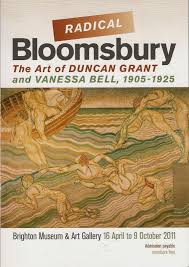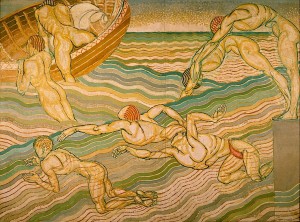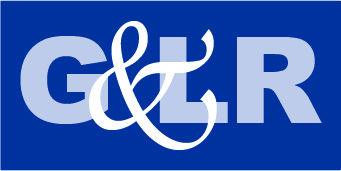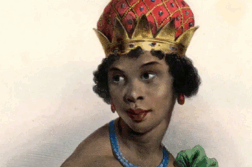 Radical Bloomsbury: The Art of Duncan Grant and Vanessa Bell, 1905-1925
Radical Bloomsbury: The Art of Duncan Grant and Vanessa Bell, 1905-1925
Brighton Museum and Art Gallery,
Brighton, UK
April 16-October 9, 2011
IN NOVEMBER, 1910, a small but important art show opened in the Grafton Galleries in London. Titled Manet and the Post-Impressionists, the show was curated by Roger Fry, a member of the Bloomsbury group, a painter, art critic, and at different times the lover of Duncan Grant and Vanessa Bell. This was one of the earliest shows in London dedicated to Impressionist and Post-Impressionist French art.
The critics were in general disgusted by the show as yet another sign of the decadence of the British Empire and saw it as a frivolous foray into French æsthetics. Post-Impressionist art, a term Fry coined, would soon be associated with labor unrest, anarchists, Irish demands for Home Rule, and the suffragettes’ increasing agitation for the right to vote. Just days after the show opened, suffragettes protested at the House of Commons while its members were debating the question of women’s rights. As Frances Spalding notes in her 1997 biography of Duncan Grant, the protest resulted in 117 arrests, which “set off a program of window-smashing, arson and bombs as the suffragettes, denied political power through the normal democratic procedures, resorted to violence.” Political protests and art controversies comingled that winter and created a moment about which Bell’s sister Virginia Woolf would later declare famously: “On or about December 1910 human nature changed.”
It is perhaps significant, then, that the word “radical” needed to be included in the title of this past summer’s exhibition of the art of Duncan Grant and Vanessa Bell at the Brighton Museum and Art Gallery. The word reminds us that their art and ideas were often a subject of disdain, particularly in the years between the death of Queen Victoria in 1901 and the assassination of Archduke Franz Ferdinand in Sarajevo in 1914—that brief moment in European history when the past looked old and the future was filled with dynamic possibilities. Critics were often hostile to the writers and artists of Bloomsbury, calling them the “pansy clan” with “not very robust talents.” D. H. Lawrence called them “horrible and unclean.” It was not until the 1960’s and 70’s that their writings and art would find a new audience and enthusiasts who admired not only their talents but also their ideas. An article about Bloomsbury in the Gay Sunshine Journal in 1978 concluded: “Their lifestyle did begin to shatter the molds, to break the chains and to crack open the closet doors of oppression for those of us who follow.” While Duncan Grant and Vanessa Bell have often been marginalized in discussions of Bloomsbury, this exhibition was part of the continuing wave of revitalizing the life and work of both. Bell and Grant were “privileged children of British elites and Empire,” as the exhibition text noted, but while their social status bore this family privilege, they often rejected the traditions and proprieties of their class. Born in 1885, Grant was the son of an officer in the British army stationed in Burma, where he spent his childhood until the age of nine when he was sent to London for schooling. In his youth and early twenties, Grant traveled through Europe and North Africa, studied painting in Paris—where he met Picasso and Matisse—and eventually went to Cambridge. It was through his friendships and intimacies with fellow Cambridge students John Maynard Keynes and Lytton Strachey that Grant met Bell and entered the artistic and intellectual orbit of the Bloomsbury circle, which was anchored at 46 Gordon Square in London. Bell, four years younger than Grant, was the daughter of the scholar and writer Leslie Stephen and grew up in the intellectual and artistic world of middle-class London. She married art critic Clive Bell in 1907 and had two children, Julian and Quentin, soon thereafter. Clive and Vanessa maintained an open marriage, and Vanessa would eventually pursue intimate relationships with art critic Roger Fry and with Grant himself, though the latter was involved sexually with other men, including Fry, throughout his life. But Bell and Grant maintained an intimacy that lasted until Bell’s death in 1961. Their relationship was grounded on a passion for art and a passion for each other. Their sexual lives were as radical as their art. Radical Bloomsbury made a simple claim: Bell and Grant, through their encounters and experiments with Post-Impressionism, Cubism, and Fauvism, influenced the direction of painting in England. It’s a compelling argument that narrows its focus upon these two painters as the center of a constellation of modern and orientalist æsthetics, absorbing and experimenting with new ways of painting. The first painting that I encountered in the show was Grant’s Bathers (1911), a highly stylized mural of seven men diving and swimming amid waves represented by curving lines that are beautifully hypnotic. The composition takes your eye from the shore through the water toward a rowboat that perches on the right-hand corner of the canvas. It may be a composition of seven men, but on closer contemplation it could be a play on the motions of one man, from shore to boat, his movements through time captured in the space of a single painting. The piece was part of a set of murals that Fry curated for the dining hall of the Borough Polytechnic in London in 1911. Grant was one of several artists who created contemporary scenes of everyday London life in strong contrast to the usual motifs of such murals of the day, which often presented moralistic or patriotic themes—particularly for the dinning halls of working-class students. The large mural draws you into the scene, but your eyes are attracted not only to the details of modernist flat surfaces and the “Byzantine mosaics,” as the exhibition text notes, but also to the bodies of the men, elongated and deeply muscled, turned and twisted so that the chests, arms, legs, and buttocks take hold of your gaze. It is a mural that celebrates the beauty and form of the athletic male body. There are other bodies to consider in the show as well. Bell’s serene painting The Tub (1917) presents a naked woman standing next to a flattened round washing tub. She seems to be lost in contemplation as she twists the end of her hair. The thick brush strokes of heavy ecru and yellow tones give way to a background that opens up to a red vase on a large window sill, framing a blue-green sky beyond. Then there’s Grant’s The Kitchen (1917), a domestic scene that mixes a number of influences from Matisse’s forms to Picasso’s faces to Cezanne’s palette. The canvas presents a domestic moment in the farmhouse in Sussex to which Bell, her husband, their two small children, Grant, and his lover David Garnett moved in 1916. With an open mix of relationships and intimacies, it must have been one of the most unconventional households in England. For Grant and Garnett, the farmhouse allowed them to fulfill their wartime duties working the land as conscientious objectors to the war. The painting anchors itself around the Madonna-and-Child-like pose of a woman (most likely Bell) in the center who’s holding her young child, while the rest of the household circulates around her: tables and chairs, shelves of cookware, servants, and family. In the right-hand corner, barely in the frame, a timid, naked man, observed from behind, turns his head to stare out at the viewer. The text says that this may be Grant himself. Or perhaps it could be his lover, naked there in the mix of domestic kitchen life. The painting intrigues us with this mysterious context of meaning, but the canvas itself feels too chaotic, with too many things going on at once and too many things borrowed from the French and Spanish modernists, to give the work an æsthetic wholeness. But then, this is the feeling I had throughout the show, for it often struggled to find a central concern, or a big idea about Grant and Bell’s art. Ranging from themed sections entitled “The Exotic, The Oriental, the Ornamental” to “Encounters with Modernism,” “English Expressionism,” “Abstract Adventures,” and finally “Homes and Carnivals,” the show felt quite fragmented and unsure of itself. What we end up confronting are two artists whose work, at least in these early years, was less about developing a distinctive “British” modernism than about experimentation in modernism itself—as transported from Paris or the “exotic” beyond. We see throughout the show echoes of Picasso and Matisse, Seurat and Cezanne. And we also see Fry everywhere in the show, whose ideas about art and the importance of æsthetic form over representational verisimilitude were crucial to Bell and Grant. “In general,” wrote Fry in his essay “Art and Life,” “the effect of the [modern art]movement has been to render the artist intensely conscious of the æsthetic unity of the work of art, but singularly naïve and simple as regards other considerations.” In this, Fry shifted the understanding of art from the domain of the cultural and critical establishments to the more individualized experience of the artist at work. The critic and painter were part of the revolution of art that the Bloomsbury group celebrated, in which the subjectivity of experience mattered more than some kind of photographic reality in painting. Psychology and sex were also important to that modern sensibility, which was busily shedding the burdens of Victorian proprieties. (Recall that Virginia and Leonard Woolf were the first to publish Freud in English.) And there’s that other aspect of the word “radical” by which Bell and Grant are linked through their complex sexual lives. While Grant maintained a number of relationships with men inside and outside the Bloomsbury “pansy clan,” his relationship with Bell resulted in Bell’s third child Angelica—who, interestingly enough, ended up marrying Garnett, Grant’s lover of the war years, much to the anger of Vanessa and Clive. But this part of their lives resided in the shadows of the London show, left either as an open secret for the patrons to figure out or as an inconsequential detail. In this way, the show denied a crucial quality of their art and a crucial aspect of modernism itself—an emphasis on the intimacies of individual subjectivities. Consider Grant’s painting Bathers by the Pond (1920) with it pointillist technique that captures a group of men enjoying not only the water on a warm day but also the pleasures of each other, as captured in the glances of the three men in the foreground. Like the earlier mural, 1911’s Bathers, this painting forces us to look at men’s bodies exposed and reclined. The penis of the reclining man in the foreground is lit in the noonday sun and practically centers the whole painting. The æsthetic experience in many of these paintings is often charged with an erotic intimacy that was crucial to the art. Biographer Frances Spalding recounts a letter Bell wrote to Fry announcing a desire that she and Grant shared in creating more indecent art. “I suggest a series of copulations in strange attitudes and have offered to pose,” wrote Bell, adding: “Will you join? I mean in the painting. We think there ought to be more indecent pictures painted.” Whether such paintings were completed is not clear, and Radical Bloomsbury did not show much evidence of such work. Bell’s intentions reflected an interest in merging the radical æsthetics of Post-Impressionism with the radical experiences of their own entangled sex lives. Their embrace of orientalist art, for example, evokes not only their travels and the crosscurrents of their times but also an embrace of sexual subjectivities beyond the confines of middle-class Britain. When the Ballets Russes first performed in London in 1911, Bell and Grant were enthralled and inspired by the mingling of eroticism and exoticism, embodied fully in the elegant and expressive gestures of the dancer Vaslav Nijinsky. Bell’s Byzantine Lady (1912) is an echo of the ballet in the ornamentation and beauty of the subject, captured in quick lines and stark colors. In the poised face of the subject with eyes closed in contemplation or distress, there is a theatrical quality. The painting presents not solely a portrait but more a gesture of emotion dramatized in color and light and presented for the pleasure of our gaze. In their time, many thought Grant’s and Bell’s paintings were quite indecent or lacked a certain skill. The revolution in literary and artistic expression in England that they were firmly at the center of was one where art, psychology, and desire converged. We need to see these artists for what they were exploring in their art and their lives. Their works were experiments with modernist expression and techniques by artists who were trying to represent new subjectivities and new ways of seeing, modalities that were as modern and radical as those of the suffragettes smashing store windows. James Polchin teaches writing at NYU and is the founder and editor of the site Writing in Public.




